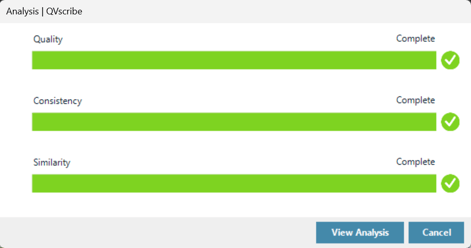Analyzing your Requirements in QVscribe for Word
Once you have selected all the requirements you would like to analyze and ensured that QVscribe is using the appropriate analysis Configuration for your document, press the Analyze # Requirements.

Once you press Analyze # Requirements a pop-up window will appear showing the analysis in progress. The duration of the analysis will depend on the number and size of requirements confirmed. This should not take longer than a couple of minutes.

QVscribe performs three distinct types of analysis on the selected requirements, each focusing on a key area:
1. Requirements Quality:Each requirement is assessed and scored based on the analysis configuration that encodes established requirements engineering standards, the INCOSE Guide for Writing Requirements and best practices. The quality analysis uses the following set of Key Problem Types in its algorithms (more details on these Problem Types can be found in Table 1):
- No Imperatives
- Negative Imperatives
- Multiple Imperatives
- Vague Words
- Optional Escape Clauses
- Optional Open-Ended Clauses
- Superfluous Infinitives
- Cross Referencing Pronouns
- Immeasurable Quantification
- Non-specific Temporal Words
- Excessive Continuances
- No Directives
- Justification(warning)
- Universal Quantifiers (warning)
- Passive Voice (warning)
- Incomplete sentence (warning)
These Problem Types are assessed based on the presence of user-configurable words and phrases defined in the QVscribe Configuration.
2. Term and Unit Consistency:
For term consistency analysis, QVscribe detects and highlights all noun-phrases found in the requirements and displays them along with the requirements containing them along with any similar terms. This helps verify that domain-specific terminology is consistent throughout the document and that the correct terms are used in each requirement. For unit consistency analysis, QVscribe detects and highlights all units in the selected requirements based on the list of units in the QVscribe Configuration. The detected units are displayed by type, along with the requirements containing them. This helps assess that all units are correct and consistent throughout the requirements.
3. Requirements Similarity: QVscribe analyzes the syntax of each requirement and shows any requirements found that are similar to it. The level of similarity can be tuned higher or lower to help assess if duplicates or contradicting requirements are present.
.png?width=75&height=75&name=4.0%20(7).png)